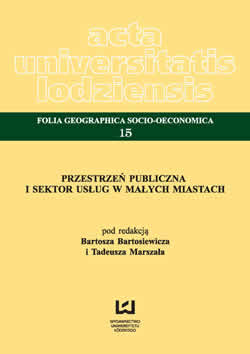Przekształcenia terenów poprzemysłowych na funkcje usługowe w planowaniu przestrzennym - wybrane aspekty na przykładzie Starogardu Gdańskiego
DOI:
https://doi.org/10.18778/1508-1117.15.14Słowa kluczowe:
przekształcenia terenów poprzemysłowych, małe miasta, Starogard GdańskiAbstrakt
Przekształcenia terenów poprzemysłowych to proces mający znaczący wpływ na struktury miast ze względu na stosunkowo duże powierzchnie tych terenów w odniesieniu do skali małych miast. Rewitalizacja tych terenów wymaga opracowania dokumentów planistycznych takich jak studia, koncepcje analizujące całościowo obszary miast. Niestety najczęściej opracowywane są miejscowe plany zagospodarowania przestrzennego (mpzp) dla poszczególnych kwartałów czy wręcz działek celem przeprowadzenia procesów budowlanych. Inwestorem dla takich terenów w małych miastach są coraz częściej zarządcy i deweloperzy centrów handlowych, z zamiarem realizacji monofunkcyjnych obszarów usługowych. Istotnym aspektem jest realizacja przestrzeni pseudopublicznych, stanowiących konkurencję dla przestrzeni faktycznie publicznych małych miast. Przykładem takich przekształceń jest proces sprzedaży i przebudowy terenów po zakładach produkcyjnych i farmaceutycznych położonych w bezpośrednim sąsiedztwie śródmieścia Starogardu Gdańskiego. Dyskusja nad koncepcją zagospodarowania tych terenów trwa od prawie 10 lat. Pierwsze koncepcje zawierały szeroki program wielofunkcyjny, ale podczas konsultacji z inwestorami przy udziale samorządu lokalnego program ten był systematycznie okrajany i ostatecznie przybrał formę daleką od początkowych idei i założeń. W przypadku Starogardu Gdańskiego udało się zabezpieczyć w prawie lokalnym jedynie konieczne do realizacji inwestycje dodatkowe poprzedzające budowę galerii handlowych, częściowe dopuszczenie wielofunkcyjności i wymagane urządzenie (skromnych w skali) przestrzeni publicznych.
Bibliografia
Ledwoń S., 2008, Centrum handlowe a układy tradycyjne, opracowanie na potrzeby projektu miejscowego planu zagospodarowania przestrzennego dla PPR „Dom” sp. z o.o., Starogard Gdański.
Google Scholar
Pancewicz Ł., 2008, Raport – analiza studiów przypadku rozwiązań projektowych centrów handlowych w małych i średnich miast w Irlandii i Wielkiej Brytanii, opracowanie na potrzeby projektu miejscowego planu zagospodarowania przestrzennego dla PPR „Dom” sp. z o.o., Starogard Gdański.
Google Scholar
Pobrania
Opublikowane
Jak cytować
Numer
Dział
Licencja

Utwór dostępny jest na licencji Creative Commons Uznanie autorstwa – Użycie niekomercyjne – Bez utworów zależnych 4.0 Międzynarodowe.








